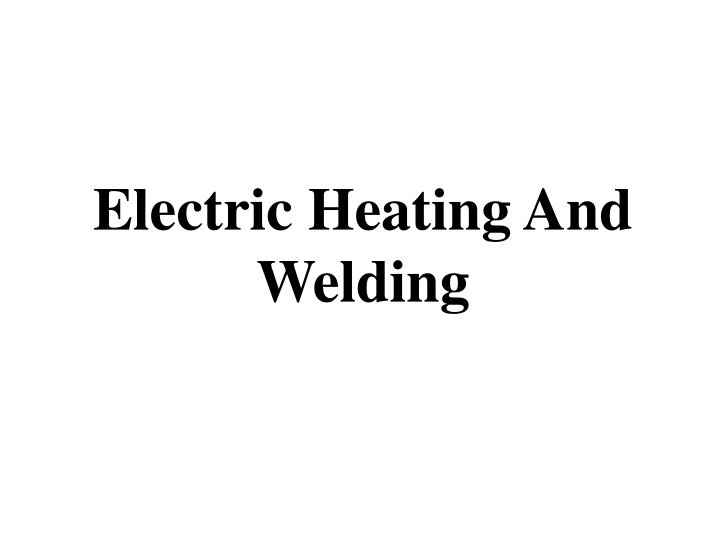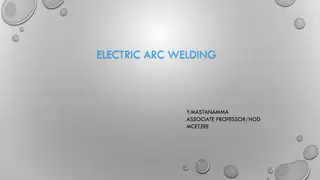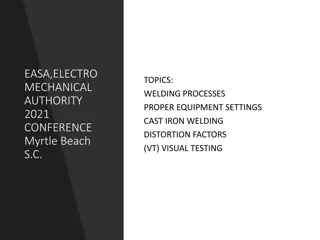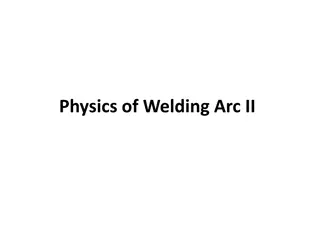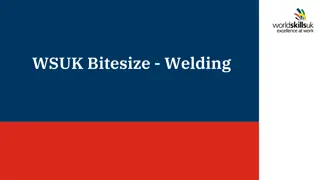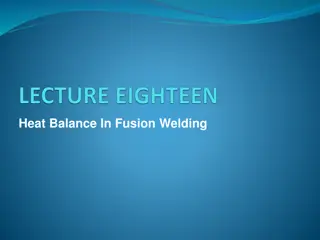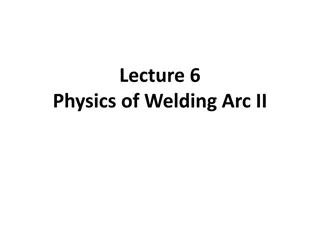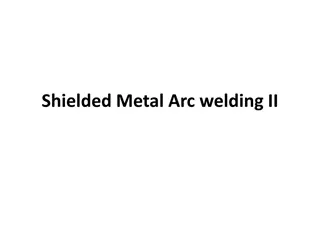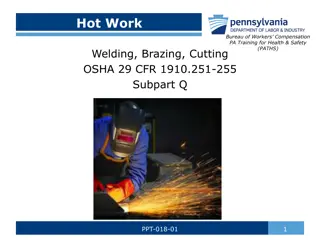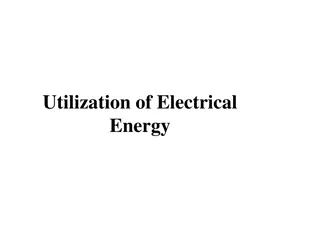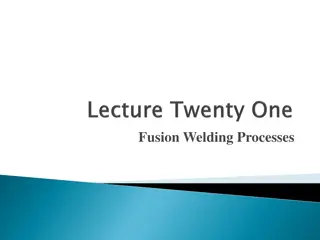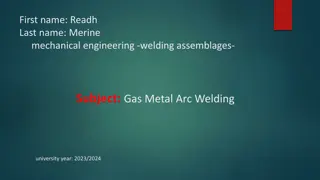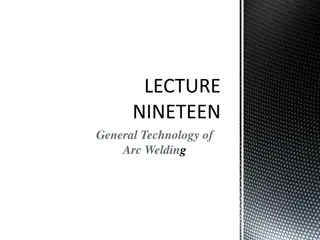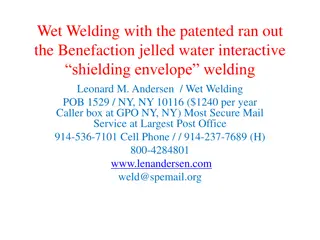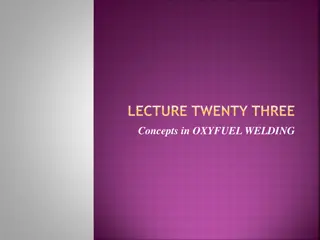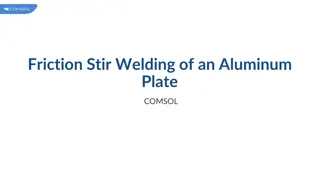Electric Heating and Welding: Applications and Advantages
Electric heating is utilized in both industrial and domestic settings for various applications like cooking, heating, and metal treatment. It offers advantages such as cleanliness, safety, and the ability to attain high temperatures efficiently. Different types of electric heating methods include resistance heating and induction heating.
Download Presentation

Please find below an Image/Link to download the presentation.
The content on the website is provided AS IS for your information and personal use only. It may not be sold, licensed, or shared on other websites without obtaining consent from the author.If you encounter any issues during the download, it is possible that the publisher has removed the file from their server.
You are allowed to download the files provided on this website for personal or commercial use, subject to the condition that they are used lawfully. All files are the property of their respective owners.
The content on the website is provided AS IS for your information and personal use only. It may not be sold, licensed, or shared on other websites without obtaining consent from the author.
E N D
Presentation Transcript
Electric Heating And Welding
Introduction Electric heating is used for industrial as well as domestic applications. Some of them are as follows: Domestic applications: 1. Electric irons 5. Hot plates for cooking 2. Electric kettles 6. Water heaters 3. Electric ovens 7. Room heaters 4. toasters
Industrial applications: 1. Heat treatment of insulators 2. Copper wires enamelling 3. For heat treatment of metals 4. To melt various metals 5. Glass moulding
Advantages of electric heating: 1. Electrical heating processes are clean due to absence of smokes, ash, dust etc. 2. As fuel gases are absent in the heating processes, there is no risk of any pollution. 3. Electrical heating equipment is more safe as electrical tripping devices act reliably and instantaneously upon abnormal conditions. 4. Electrical heaters usually require very little attention and maintenance. 5. Very high temperatures can be obtained. 6. Time required to attain these temperatures is less. 7. Fuel need not be stored. 8. Energy spent can be metered and measured.
Types of Electrical Heating The classification of electric heating:
Resistance Heating In this method, when a resistance R carries a current I for t seconds, I2Rt is the heat produced. This heat is used for heating purpose. There are two types of resistance heating, direct and indirect heating. 1. Direct resistance heating: Usually, the body to be heated is called a charge. In this process, the electric current is passed through the charge itself. As the heat is developed in the charge itself, this becomes a very efficient process of heating. ex. Water heater
2. Indirect resistance heating: In this method, heat is transferred to the charge by conduction, convection or radiation. Applications: 1. Water geyser 2. Cooking oven 3. Furnaces 4. Room heaters 5. Heat treatment of metals 6. Pottery work
Induction heating According to Faraday s law, when a magnetic flux links with a conducting body, EMF is induced in the body and thus current flows in it. This principle is used for the purpose of heating bodies which have sufficiently low resistivity. Square of the current induced multiplied by body resistance is the power utilized in heating the body. Therefore, this type of heating can be used for the bodies which are conducting in nature.
Eddy Current Heating By heating an article by eddy currents, it is placed in-side a high frequency a.c. current-carrying coil. The alternating magnetic field produced by the coil sets up eddy currents in the article which, consequently, gets heated up. Such a coil is known as heater. coil or work coil & the material to be heated is known as charge or load. Primarily, It is the eddy current loss which is responsible for the production of heat although hysteresis loss also contributes to some extent in the case of non magnetic material. The eddy current loss We b2 f2. Hence, this loss can be controlled by controlling flux density B and the supply frequency f. This loss is greatest on surface of the material but decreases as we go deep inside.
Applications: 1. Surface hardening of metals. 2. Annealing of metals. 3. Brazing. 4. Soldering. 5. Induction cooking.
Dielectric heating In dielectric heating, a high frequency, high ac voltage is applied across a dielectric material. The dielectric work piece is held between two metal electrodes. The dielectric material can be plastic, wood etc. Due to high voltage RF excitation, some current flows through dielectric material and due to this flow some loss takes place in the dielectric which is called as dielectric loss. This power loss takes place in the form of heat and the dielectric material gets heated up due to it. This is the principle of dielectric heating.
Applications: 1. Gluing, curing and drying of wood. 2. Preheating plastic perform of condition them for moulding. 3. Plastic sewing. 4. Drying and heat treatment of natural and synthetic rubber, rayon, nylon etc. 5. Processing of chemicals during manufacture.
Electric Welding Welding is the process of joining two pieces of metal or non metal by applying heat or/and pressure. Classification: All the welding processes are classified as 1. Fusion welding 2. Non-fusion welding
1. Fusion welding: This type of welding takes place by melting the two metals to be welded together. Examples of fusion welding: i. Gas welding ii. Electron beam welding iii. Electrogas welding iv. Carbon arc welding
2. Non-fusion welding: In this type of welding the metals to be welded together need not be melted. Examples o0f non fusion welding are as follows: 1. Resistance welding 2. Gas non fusion welding 3. Ultrasound welding 4. Friction welding
Arc welding The electrodes used for this welding are made up of carbon or graphite. An electric arc is struck when the short-ciruited electrodes are separated a little bit. In the process of withdrawing the electrodes apart, the area of contact of electrodes first reduces which increases the resistance producing large localized heat and then on actual separation of electrodes, arc is struck. Due to high temperature of arc, electrode melts and weld is produced.
Classification of arc welding: 1. Metal arc welding 2. Carbon arc welding 3. Atomic hydrogen welding
1. Metal arc welding: In this type, the welding electrode itself is made up of the filler metal. At the time of welding the current flows through the welding electrode, arc, work piece to earth. It is possible to use ac or dc supply.
2. Carbon arc welding: The electrodes used in this system are of carbon or graphite. The supply voltage should be dc. The work piece to be welded is connected to positive end of the supply and the carbon electrode is connected to the negative end. Huge current of the order of 800 to 1000 A are drawn from the dc supply at the time of welding.
3. Atomic hydrogen welding: In this method, the tungsten electrodes are kept in the hydrogen atmosphere. The arcing takes place between the two tungsten electrodes. Hydrogen acts as an agent which atomises and maintains the arc between the electrodes independent of the work pieces to be welded. The hydrogen acts in two fold manner, as a cooling agent as well as a protective screen.
